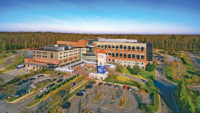The first building, a residential tower dubbed BLVD, was designed by Hickok Cole Architects, Washington, D.C. "In addition to working with Comstock, the county and our own team, every building has its own team," Sakla says. "At one point, we met every day for more than a month to improve coordination and productivity."
One focus was vehicular access points below the residential tower, because thousands of cars and buses were expected to move through the facility during rush hour. The garage has five lanes entering and exiting it. Buses and "kiss and ride" users have access through the same corridor.
The design called for 60-ft-by-60-ft spans at the garage entrance, but needed to support a 21-story, eight-column section of the building above. The structural engineer, Luis Fernandez of Fernandez and Associates, Falls Church, Va., devised what he called the "elephant stand" solution, named after a circus act he saw as a child, in which an elephant stood on one leg atop a small platform.
Fernandez's concept included an exterior 60-ft-by-60-ft structural beam tension ring; an interior 30-ft-by-30-ft structural steel tension ring; and four diagonal hybrid connectors, which used steel beams. Beam sizes were W31 x 655 lb per ft.
The interior 30-ft-by-30-ft section was located to meet where four interior corner columns from the building above would land. A system of struts and ties using a triangular-shaped section connected the interior section to the end nodal points at the four outside supporting columns.
Compression forces delivered through triangular concrete elements were transferred to horizontal diagonal steel beams that interconnect the inside and outside tension rings by means of reinforced concrete. Some of the forces land on top of the beams' flanges at about a 30-degree angle.
Fernandez says those forces had to be transferred through a "washboard" of saw-toothed plates and stiffeners, which shifted the compression forces onto the steel beams.
Mesich says the system required 16 pieces of steel, which were fabricated in Charlotte, N.C. Sections weighed as much as 30,000 lb. It took crews six days to erect the elephant stand and six weeks to weld the connections. Some portions were encased in 10,000 psi self-consolidating concrete.












Post a comment to this article
Report Abusive Comment